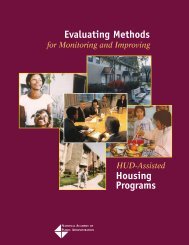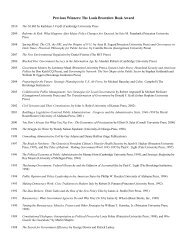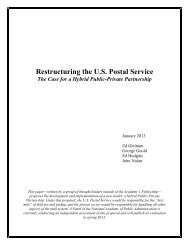High-Performance Partnerships - National Academy of Public ...
High-Performance Partnerships - National Academy of Public ...
High-Performance Partnerships - National Academy of Public ...
Create successful ePaper yourself
Turn your PDF publications into a flip-book with our unique Google optimized e-Paper software.
and establishing performance management systems.<br />
This report does not repeat the information<br />
available from these resources. Instead, the<br />
design labs focused on identifying major challenges<br />
that a partnership can face and strategies<br />
to address them.<br />
Table 4-1 gives some tips for measuring performance,<br />
as well as traps to avoid. <strong>Academy</strong> Fellows<br />
Gail Christopher and Camille Cates Barnett<br />
developed the list.<br />
DEFINING SUCCESS<br />
The Challenges<br />
Success is in the eye <strong>of</strong> the beholder. Partners<br />
and stakeholders may have very different<br />
notions <strong>of</strong> how to measure success on any<br />
given issue. For example, communities that<br />
struggle to provide affordable housing can<br />
measure success using a range <strong>of</strong> statistics,<br />
such as a reduction in homelessness, fewer<br />
people living in substandard housing, decrease<br />
in the percentage <strong>of</strong> income required to obtain<br />
housing, and increased home ownership for<br />
low and moderate-income families. All <strong>of</strong><br />
these measures are valid, yet achieving them<br />
requires different strategies.<br />
Defining high performance is difficult, yet central<br />
to significant, long-term community improvement.<br />
Oakland’s Safe Passages provides one example <strong>of</strong><br />
defining very specific high performance results:<br />
• Reduce youth arrests for violent <strong>of</strong>fenses by 35<br />
percent by 2005.<br />
• Reduce suspensions for violence by 30 percent<br />
at 10 middle schools by 2005.<br />
Once a partnership determines performance<br />
indicators, it must decide the targets <strong>of</strong> success.<br />
Using the previous example, does a 5 percent<br />
increase in low and moderate-income home<br />
ownership equal high performance? Or, does<br />
it take a 10 percent increase? How can a public/nonpr<strong>of</strong>it<br />
partnership set goals that achieve<br />
extraordinary results, yet not be so ambitious<br />
as to doom the effort? Even broad-based partnerships<br />
cannot exclusively solve significant<br />
community issues. As a result, some organizations<br />
may be reluctant to be held accountable<br />
for outcomes beyond their direct control. If<br />
the partnership is not willing to be accountable<br />
for the bottom line result, however, who is?<br />
TABLE 4-1<br />
TIPS AND TRAPS FOR MEASURING PERFORMANCE<br />
TIPS<br />
Focus on results that matter.<br />
Keep it simple.<br />
Focus on the critical few.<br />
Link performance measurement<br />
to decisions.<br />
Success is not instant.<br />
Ask customers what they want.<br />
Report results widely.<br />
Data are a necessary expense.<br />
Don’t give up.<br />
TRAPS<br />
Measure what is available.<br />
Dazzle them with statistics.<br />
Try to measure everything.<br />
View performance measurement as an end,<br />
not a means.<br />
Change course at will.<br />
This is a job for pr<strong>of</strong>essionals.<br />
Use performance measures to blame people.<br />
Expect measures to report on themselves.<br />
Inaction: It is easy to avoid the hard work <strong>of</strong><br />
focusing on results.<br />
67 Powering the Future: <strong>High</strong>-<strong>Performance</strong> <strong>Partnerships</strong>









